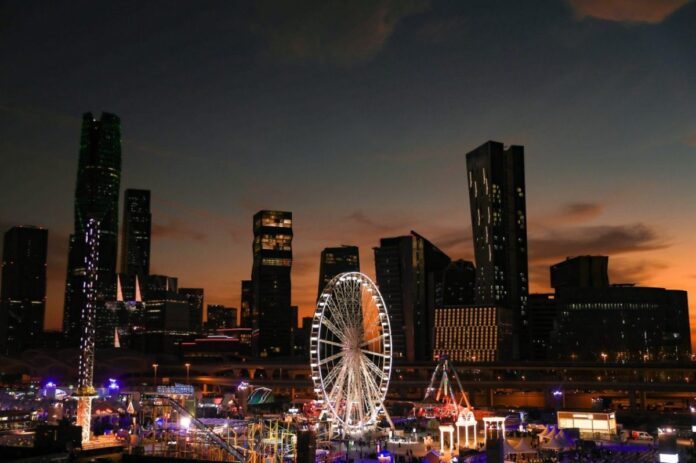Skift Take
With a goal to attract 100 million tourists a year by 2030, Saudi Arabia realizes that it will have to promote itself aggressively as a leisure destination. A trillion dollars looks pretty aggressive.
In addition to the investment that it has already made in the last five years, Saudi Arabia plans to invest another $1 trillion in the tourism sector over the next 10 years.
“Today, Saudi Arabia is the largest investing destination in the tourism sector,” said Fahd Hamidaddin, CEO of the Saudi Tourism Authority.
Having set the ball rolling, the destination has signed up Argentinian soccer star Lionel Messi as its newest tourism ambassador even as American golfer Jack Nicklaus says he turned down $100 million to be the face of Saudi-backed LIV Golf Series according to reports on Monday.
Of course, the country historically struggled to win over both domestic and international tourists due to societal limitations, including a strict no-drinking policy and severe restrictions for women, as well as allegations of human rights abuses against journalists.
But the once popular religious destination is now pivoting towards leisure tourism with a calendar of events which would have once seemed unimaginable in the country. And then there is the goal to attract 100 million tourists a year by 2030.
Outlining its tourism aspirations to align with the 2030 Vision, Saudi Arabia identifies tourism as one of the “promising sectors” to help diversify its primarily oil-based economy.
A Skift report in 2019 had also identified that Saudi Arabia has been making significant moves to open up its borders to international tourists.
The Riyadh Season 2021, an entertainment event that spanned over five months from October 2021 onwards, was one such entertainment event to attract leisure tourists.
The opening ceremony, which had American rapper Pitbull performing, was attended by more than 750,000 people, while being broadcast live across television channels and websites.
“We had an active lifestyle offering with the Riyadh Season 2021, which had festivities and events from music to culture and lifestyle,” .
The country is all set to welcome a Nobu Hotel and a St Regis in Riyadh with another Four Seasons to come up at Diriyah — the original home of the Saudi royal family.
The Saudi Arabian port city of Jeddah had been buzzing with activity in December last year as it hosted the debut edition of the Red Sea International Film Festival as well as the Formula One Grand Prix.
The country has also hosted a growing number of international sporting events, including the Italian Super Cup and the Spanish Super Cup.
Using the Covid Downtime for Promotion
At a time when very few destinations were promoting tourism as a result of sealed borders, Saudi Arabia used the Covid downtime to promote tourism to the country.
The gamble paid off as 2021 was a remarkable year for the destination with domestic tourism reaching a record high of 62 million visits. “We had 15 million visits to the Red Sea from the region,” Hamidaddin said while talking to Skift at the Arabian Travel Market in Dubai.
“In terms of total recovery, we reached 72 percent of pre-pandemic levels in 2021. The last quarter of 2021-2022 has been extremely rewarding as we reached 130 percent of pre-pandemic levels. Today, Saudi Arabia is the largest investing destination in the tourism sector,” Hamidaddin said.
Fahd Hamidaddin, CEO of Saudi Tourism Authority.
Private-Public Collaboration
In its bid to turn into a rewarding destination for travelers, Saudi tourism is also keen to make governments and businesses work together.
Crediting the Covid environment for inspiring a new wave of collaboration between governments and the private sector, the Saudi Tourism CEO said that at a time when it was needed the most, public and private entities came together to enhance existing services and develop new ones.
“We never thought this would click until the public and private entities were forced to work together and they went on to create an integrated value chain of tests, apps, quarantines upon arrival and hotel check-ins,” Hamidaddin said.
While this synergy helped to save lives during Covid, Hamidaddin said this should now be further developed to help create a seamless experience for travelers.
However, Saudi is mindful of the fact that while coming out of the pandemic, destinations need to ensure that the environment continues to heal.
“We never had overtourism because we were still a new destination, and we will ensure that everything that we build is designed with that in mind,” he said, pointing out that Saudi Arabia has committed 30 percent of the total land to protected areas as part of Vision 2030.
Regional Tourism Pitch
With cities around the world actively working to promote themselves, destination branding is indeed a very competitive landscape globally. However, Saudi is looking to compete with destinations on a regional level while looking to promote tourism within the region.
“Long-haul travelers don’t just intend to visit one country. A traveler to Jordan’s Petra can extend their trip to Saudi’s Al Ula and further. We are looking to collaborate on multiple levels with other countries in the region, and tourism promotion is definitely one of them,” Hamidaddin said.
However, with destinations in the Middle East bullish about tourism, Saudi Arabia will have its task cut out to capture its share of the market.










